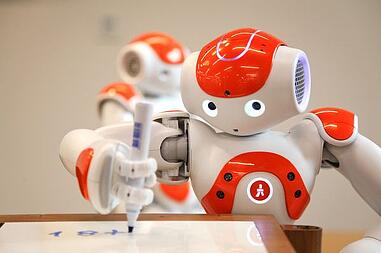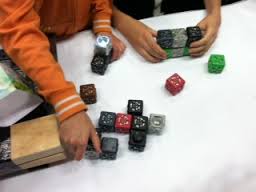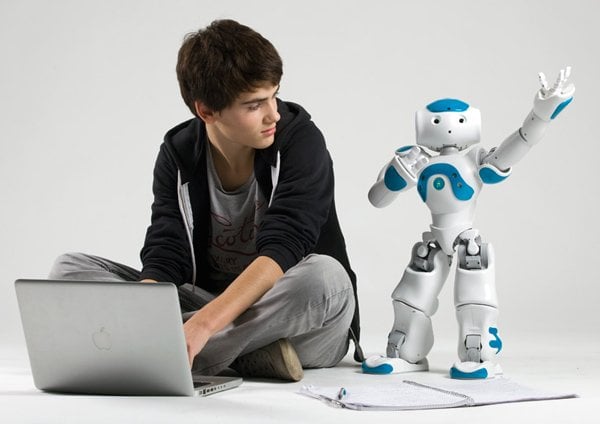RobotLAB Blog
Everything You Need To Know About Robotics in Businesses
NAO robot illustrating a TechCrunch article
Wondering how to teach a kid to write? How about helping a kid teach a robot to write? Committed teachers have been saying forever that they learned more from their students than they learned from them. Might this have the same profound effect on students working from the teacher’s perspective?I don’t have the answer to this riddle. The question simply came to me when I stumbled over this great picture of the French company Aldebaran’s anthropomorphic robot NAO hovering studiously over a digital pad seemingly writing an earnings report for the Associated Press. Looking stiff with the pencil at an uncomfortable angle and totally focused, doesn’t NAO look a lot like a kid learning to write?
Actually the blog post with this picture is talking about robots that look less like humans and more like computers. But how better to illustrate the point that computers are freeing humans from boring jobs? NAO, after all, is the most widely used anthropomorphic robot for educational and research purposes.
Not only anthropomorphic, but autonomous also. Which brings me back to the question about NAO as a possible student and the student as a teacher. In my experience kids like to act like teachers. I know I did, and I can remember my youngest teaching to an attentive Jack Russell Terrier. NAO is programmed to be even more attentive than the Jack Russell--and speaks better English--and French, German, and dozens more. NAO is better disciplined also and won’t interrupt the teacher with barking when the doorbell rings.
NAO is a favorite with us here at RobotsLAB. We put a great deal of effort into developing curricula that
provides NAO with the ability to keep kids engaged in learning. While writing copy for the AP is a stretch at the moment, it is certainly only a matter of time.
- 0 Comments
- Oct 14, 2014 4:08:00 PM
- Posted by Mike Nardine
- Topics: NAO
NAO Humanoid robot coming soon to the library
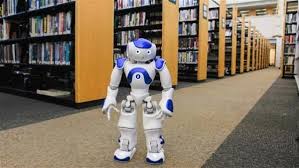
I can remember the indignation I felt the first time I found video tapes in the public library; a desecration, I thought! Libraries are for books, not light-weight, made-for-tv documentaries! I kept holding my nose when I walked by those shelves until I missed Ken Burns’s documentary The Civil War on tv and the only place I could find it was...you guessed it, the public library. Alas, virtue once lost is virtue overcome and I found myself welcoming the computer into the library (a screen search beats the old card system any day), and absolutely thrilled with the coming of the Kindle; so the idea of anthropomorphic robots on the library floor doesn’t bother me at all.
Like it or not, public libraries are in a competition with the internet for information-delivery relevance. The internet delivers text and imagery with a speed the library cannot; public libraries, on the other hand, can deliver the real thing. Watching a video about robots is interesting, but actually interacting with one is both interesting and fun--just ask any kid!
One of the first libraries to acquire these tradition shattering mechanical beasties is the WestPort Public Library in Westport Conn. The Westport library has broken the mold before; specifically, by setting up a “Maker” space for its patrons and installing a 3D printer, technology that President Obama has referred to as the “future of manufacturing.” Now, the library intends to introduce its patrons to robots. "Robotics is the next disruptive technology coming into our lives and we felt it was important to make it accessible to people so they could learn about it," said Maxine Bleiweis, executive director of the Westport Library. "From an economic-development perspective and job- and career-development perspective, it's so important."
The robots, named Vincent and Nancy, are “Nao Evolution Robots,” the latest model NAO robot created by the French robotics company Aldebaran. Standing about three-feet high and looking a bit like the anthropomorphic robot C-3PO in Star Wars, they have a mild, calming way about them that has made them an important tool in teaching autistic children. They are not simple windup toys with a limited behavioral repertoire; besides walking and talking, they recognize faces, can detect where sound is coming from, touch, feel, and avoid obstacles; more, library staff and patrons can program them to do all sorts of entertaining and even practical things, like help find books and meet children arriving at the library. Says Alex Giannini, the library digital-experience manager, "I don't know what the coolest functionality is going to be. Someone coming in off the street is probably going to teach us that."
Nao robots in libraries is a novel development (no pun intended), but these robots are by far the most popular robots used in science education and are found in schools worldwide. Many of these engaging robots have been sold by RobotsLAB along with lesson plans designed for students of all ages. Teachers interested in presenting their classes with an educational experience their students will remember for ever can find more about NAO at our website.
- 1 Comments
- Oct 13, 2014 2:37:00 PM
- Posted by Mike Nardine
- Topics:
Is doodling a good teaching tool?
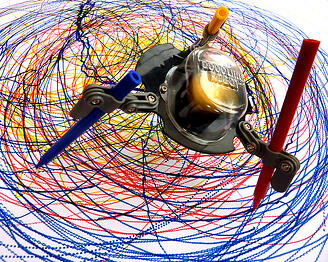
Just guessing, but if you’ve achieved an educational level that makes the overall material in this blog at all interesting you were probably a doodler when you were a student. I was, but that isn’t the only reason for this otherwise unwarranted assumption: recent studies show that doodlers retain and process 29% more information while listening to a lecture. Who knew?
Exactly why doodling provides an advantage is still a matter of conjecture. Some educators don’t care why, they are simply looking for any advantage they can find that will help students succeed. Sunni Brown from Austin, Texas is among that number. Considered one of the “100 Most Creative People in Business and one of the “10 Most Creative People on Twitter” by the business magazine, Fast Company, Ms Brown fervently believes in the power and value of doodling. She is the Chief “Infodoodler” (this position title found on Wiki) of Sunni Brown Ink, a “visual thinking consultancy” with which she pursues her passion.
- 0 Comments
- Oct 10, 2014 6:57:00 PM
- Posted by Mike Nardine
- Topics:
Tech education can't start too early!
The programming language "Scratch" is for young people that have an itch to create interactive games, stories and animations online. Designed originally for kids 8 through 16, it is offered free by the Lifelong Kindergarten Group at the Massachusetts Institute of Technology (MIT). The Lifelong Kindergarten Group believes its interactive programming language provides the young with essential skills for 21st Century employment, including the ability to think creatively, reason systematically and work collaboratively.
Scratch Jr., the newest example of this language from prestigious MIT is designed for even younger students, preschoolers as young as five. A new Ipad app is now available for these younger kids. Scratch Jr. was developed with mobile devices rather than computers in mind like Scratch. Its developers hope that the language will meet the following educational goals for younger kids:
-
give them a better understanding of literacy and math
-
help them become familiar with classifications of various computer software and mathematical components
-
help them learn to be problem solvers and thinkers and better understand science and software development
A personal note here: The last time I had babysitting duty I downloaded the Scratch Jr App to my Ipad and handed it over without comment to my seven-year-old grandson, Fox. He likes cats and I thought he might take to it. He did. Also without comment.
I wandered off leaving him completely unsupervised in my recliner with the Ipad inches from his face. When I returned a few minutes later he had already completed three projects.
“Was it fun?” I asked
“Yes.”
“Did you learn anything?” I said, knowing I was pressing my luck.
He rolled his eyes in answer and went back to playing with the app.
Another learning tool for the younger set that Fox and his three-year-old brother Dexter both like is RobotsLABS' own CUBELETS. Their small hands find these little magnetic blocks safe and easy to manipulate. They get a big kick out of the autonomous robots they can make entirely on their own. It pleases their parents and me to see them developing their ability to think procedurally and learning to solve problems in a step-by-step manner.
- 0 Comments
- Oct 9, 2014 6:24:00 PM
- Posted by Mike Nardine
- Topics:
STEM's Newest Darling: Robotics
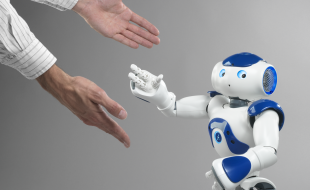
Me, being a believer in the robot as a teaching tool,I was at first a little put off by the title of a recent article in the Boston Globe, STEM's Newest Darling: Robotics; a bit cloying, I thought. The subtitle, It’s the 21st century’s newest must-study subject, came across as patronizing. I felt certain my favorite machines were in for a verbal drubbing. And guess what, after reading the entire article I've decided my first opinion was almost entirely wrong! Error! Error! Will Robinson!
Oh, I guess I could still fault the article writer for his off-putting approach in the title, but I certainly can't complain about what he had to say about robots and education; it was highly complementary and informative. It's good to see that Massachusetts, the home of the Massachusetts Institute of Technology (MIT), really gets it. Maybe it was the fear that Massachusetts, certainly one of the most progressive states in matters of education, didn't get it, that put me off at first (Ok, Ok, I won't use any further renditions of the term 'off-put' in this post!).
Anyway, Massachusetts does seem to be a hotbed for STEM learning using robotics. An elementary school in Boston’s oldest community, the North End, plans to use robots in Kindergarten classes. And the “inventor-in-residence” (a PHD from MIT) at a private school in Brookline where they intend to integrate programming into all the classes K6-12 says, “robotics is not about building real-life C-3POs, quasi-humans… Instead, it’s a way of combining sensors, computer programming, and actuators to solve problems in the physical world.” The president of Worchester Polytechnic Institute, Laurie Leshin, has this to say about the importance of introducing robots early in a student’s career and sticking with them: “Second- and third-graders get this stuff inherently,” she says. “By the time they get to middle and high school, life has beaten out of them some of that interest, and I think robots are a way to get that back.” We couldn’t agree more!
The one disagreement I still have with this article comes near the end where the author says, “The last and maybe biggest challenge, as schools try to start programs, is teachers.” The author quotes the principal of a Boston K-8 school that says it is difficult to add robots to a classroom “unless you have a person who has expertise and is motivated.” The best teacher is always a motivated teacher, but we here at RobotsLAB would argue that a motivated teacher who lacks expertise in robotics should not be held back. Any well-motivated teacher skilled in their own discipline, be that math, science, engineering or whatever, will find themselves capable of engaging and educating their class from day-one with nothing more than the material we provide with our robots.
- 0 Comments
- Oct 8, 2014 8:19:00 PM
- Posted by Mike Nardine
- Topics:
3 myths about Edtech in the classroom
A recent post on the role of technology in education made me take another look at our approach here at RobotsLAB. The post discussed three “myths” the writer found prevalent: myth 1 was that educational technology “was all about disruption;” myth 2 was that it was “all about the classroom;” and myth 3 claims “It’s all about...well...technology.”
Myth 1, says the post author, results from the tendency to over-hype the potential educational gains from new tech; people expect an entirely new educational environment. This leads, says the author, to a failure on the part of educators to incorporate the new tech with the existing system which usually leads to failure and increased skepticism by these same educators of subsequent new tech arrivals. The answer, says the author is not to view new tech as disruptive but as a tool to improve present practices.
At RobotsLAB we believe our products are “hyped” as doing exactly that: improving present practices. Our BOX, for example, doesn’t attempt to fundamentally change the study of math, but only to make it more engaging for students. It allows teachers to present their own interpretation while displaying the algorithms at work in the real world.
As for myth 2, the belief that new edtech is “all about the classroom” when there is actually a great deal of very important software for more administrative requirements, we are willing to admit that RobotsLAB’s products are indeed “all about the classroom.” Our products are developed with teachers teaching students in mind rather than software helping administrators with hiring, teacher development and data storage. We make no apologies for that, although in the future we may decide to develop more administratively directed products.
Myth 3 says that some believe that technology is an end all unto itself. We at RobotsLAB don’t even begin to believe that! We think our robotic products are wonderful tools, but only in the hands of committed and trained teachers. We are well aware of the studies that have shown that the teacher is still the most important “school-based factor” for student achievement.
- 0 Comments
- Oct 7, 2014 5:53:00 PM
- Posted by Mike Nardine
- Topics:
Algebra curriculum enhanced by rubik cube
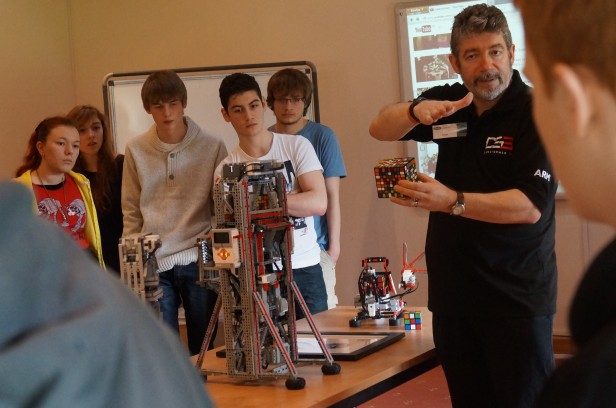
Our robots and their included curricula provide students with exciting, engaging experiences in the STEM learning disciplines. Notice the emphasis on the word ‘experiences?’ An ‘experience,’ according to Webster’s New Collegiate Dictionary (circa 1976), is “something personally encountered, undergone, or lived through.” Even better is the definition found for the verb ‘experience’ with a more modern-media Google search: ‘practical contact with and observation of facts or events.’ That practical contact, that sense of personally encountering something otherwise thought of as abstract, is what our robots can deliver. No book, no blackboard and no lecture can hope to make concrete a abstract math concept as well as interacting with NAO, the BOX and MATHBALL.
Obsessed as we are with delivering students an experience that they will remember, we are always pleased to find someone else who understands the importance of engagement in learning. One such educator is teacher Sabrina Truong at East Harlem high school. She recently discovered that the Rubiks Cube could help kids learn algebra. She stumbled across a brochure announcing You Can Do The Cube at a educational science fair. She says she followed the brochures’ algorithms and solved the Cube for the first time in her life. That experience made her think that the Cube could be a source of inspiration for her math classes. She then found more interesting material at the site, youcandothecube.com, that helped her set up a curriculum based on the Cube.
Apparently Ms. Truong’s Rubik’s Cube curriculum for algebra class was a hit immediately with both administrators and students. The principal had this to say about this new initiative: This is the first real student initiative at the school. The students took one small idea and developed it into an extraordinary competition. I am impressed by the momentum that it has gained the last three weeks. One thing that stood out is this young man, Steven, who for most of the year was a truant and yet is here to help organize the event. Congratulations to the Rubik’s Cube Club.
Congratulations to Ms. Truong for her extraordinary commitment to her students math education and the same to her principal for his ability to allow a new, untested initiative to survive long enough to prove its worth. We hope the kids at East Harlem High realize how lucky they are to have teachers like these!
- 0 Comments
- Oct 6, 2014 4:41:48 PM
- Posted by Mike Nardine
- Topics:
NAO robot introducing Kids to emerging world of robotics
Although Aldebaran’s robot NAO is far and away the most popular anthropomorphic robot used in education, there are still too few of them to go around. As yet, school systems are more interested in getting a tablet into every child’s hand rather than a robot. A shame it can’t be both as there is recent evidence out of the Robotics project of Carnegie Mellon University that suggests that kids are beginning to view the computer as a bit passé and computer programming downright boring. But few school systems have the bucks for both.
Realizing this, Murray State's Kentucky Academy of Technology Education has created a program for schools that meets both the NAO shortage and the developing engagement deficit head on. Accepting reality as in “If the mountain won't come to Muhammad then Muhammad must go to the mountain," Murray State overcame the NAO shortage by creating a virtual NAO simulacrum that behaves exactly as the actual NAO when kids program it on their too-familiar computer screens or tablets.
Programming with tools as fun and easy as drag-and-drop and as detailed as C++ and Python, the young students get to watch the NAO simulacrum behave as they program its actions on screen. Later, when one of the few actual NAOs in that school system is available at their school and in their classroom, they can use that very same program to animate it. This process seems to work wonders as area educators report that students that once held back are now stepping out as leaders and 80% of the kids that take the course are reportedly inspired to take more STEM courses.
Robots like NAO inspire kids to take more STEM courses because they keep them engaged as no other teaching tool can. Kids watching them behave at their behest suddenly find themselves feeling as if the math that up to now they never found relevant has suddenly come alive.
We here at RobotsLAB provide NAO and a number of other anthropomorphic robots like BIOLOID and DARwin-OP--along with their included curricula-- that can keep a classroom full of otherwise easily-distracted kids interested in math for an entire class period--and beyond.
- 0 Comments
- Oct 1, 2014 4:57:00 PM
- Posted by Mike Nardine
- Topics:
How robots will become soon indispensable teaching tools
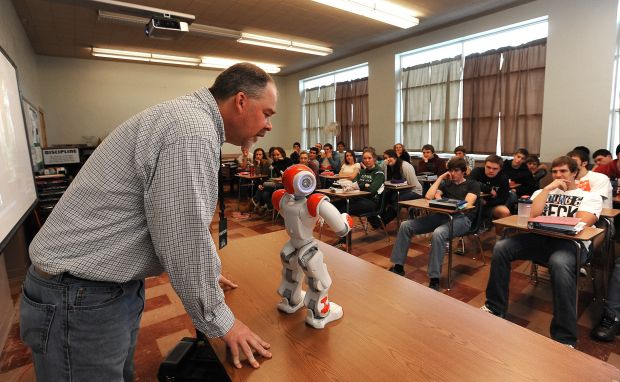
At the risk of exposing my lack of poetic ability, Robots are the new cool,/ and a soon to be/ indispensable teaching tool! Let me explain...
No one questions the commitment of the young to new technology. They take to it like fish to water or birds to the air. Why then, is there such a lack of interest in computer programing among these young tech user in high school and college? Kids that spend every free moment on the Internet still avoid learning the very disciplines that underlie this technology. The answer, according to Tom Lauwers, member of the CSBOTS project for introducing robot programming at the Robotics institute of Carnegie Mellon University, is simply that “many students find the initial work very boring.”
The people behind CSBOTS at Carnegie Mellon believe that many students find programming computers boring. Robots, on the other hand, are cool and programming them is fun. Students develop the same skills programming a cool robot as a boring computer. This situation is analogous to an earlier age with the internal-combustion engine and its most popular embodiment, the automobile: everyone drove, but fewer wanted to look under the hood and even fewer troubled themselves with the underlying physics.
The automobile is still around, of course, but the human hand and brawn have been replaced on the assembly line with...you guessed it, Robots! Robots in Israel are saving lives in ruined buildings; robots are under construction that can take the place of men in combat situations and the sky is filled with robotic flying machines, drones. Robots like RobotsLAB’s NAO are even edging into the sports field with the hope of beating a human team at soccer in a generation or two. At the moment NAO isn’t much of a threat to Lionel Messi, but it is ready for prime time in the educational arena.
In fact, NAO in education is the very embodiment of the “cool” educational robot with which Carnegie Mellon hopes to inspire a love of STEM learning and programming in more students entering college. In addition, RobotsLAB’s NAO is coupled with a curriculum that allows students to develop a structured approach to finding solutions while keeping those students interested and engaged in learning skills that will be needed in the future to secure jobs in the STEM field.
And NAO isn’t the only “cool” robot digital teaching assistant here at RobotsLAB that can help teachers keep kids engaged while learning the STEM disciplines. There’s MATHBALL, a robot in the shape of a basketball that was originally designed to help professional basketball players perfect their scoring shots and will now teach kids about parabolas in a way they will never forget. There’s the RobotsLAB BOX with several robots including AR DRONE to show kids how important math can be in their real lives. There’s BIOLOID to help teachers explain the relevance of STEM and for the younger set there’s CUBELETS for building simple robots that don’t need programing to keep them interested. Take a look at our site for more information--and less poetry.
- 0 Comments
- Sep 4, 2014 10:32:04 PM
- Posted by Mike Nardine
- Topics:
Rural Vermont school embraces edtech
I’ve never thought of Vermont as “poor and rural” inspite of the image I had of it as nothing but forests and maple syrup farms--or whatever they call them ... maple groves, maybe? So I was surprised to read about one school superintendent’s difficulty in upgrading the public schools in his district: Ned Kirsch, superintendent at Franklin West Supervisory Union (FWSU) in the small town of Georgia, Vt., population 4300.
He says that upon his arrival in Georgia, he was pleased with the schools that he found. The problems in the schools were not with the “hard-working teachers, committed administrators, and 2,000 excited students;” instead, those excited students needed a connection to the technological world outside Northern Vermont.
- 1 Comments
- Aug 1, 2014 12:00:00 PM
- Posted by Mike Nardine
- Topics: EdTech, Education, 21st Century Classroom
Relevant Posts
- Augmented Reality: A Tool for Teaching Students Robot Programming
- Fostering Innovation Through Youth Education in STEM and EdTech
- How Parents Can Foster STEM Learning Beyond the Classroom
- How Robotics Cultivates a Deep Understanding of Mathematics in Students
- RobotLAB Receives EDTech Chronicle 2023 ‘BESTIE’ Award for Landmark Partnership with American Samoa Dept. of Education.
Subscribe to Email Updates
-
I Want To Learn MoreADDITIONAL INFORMATION

